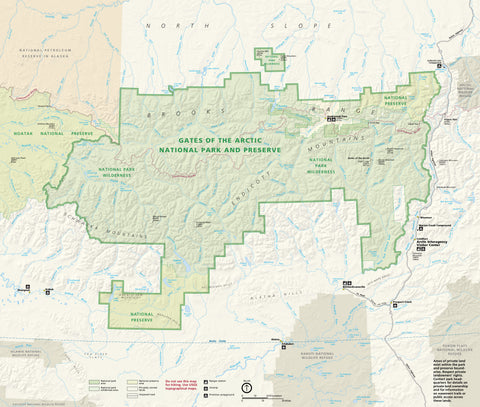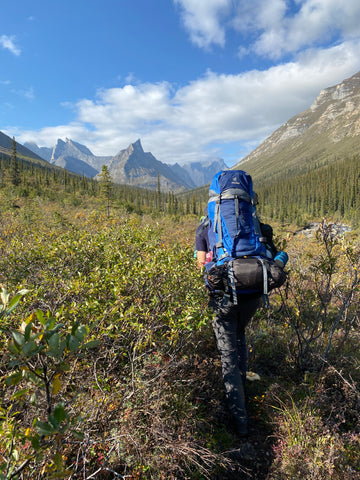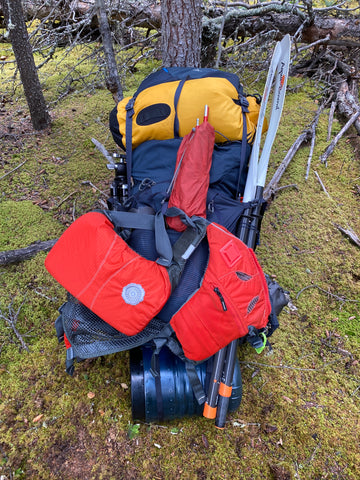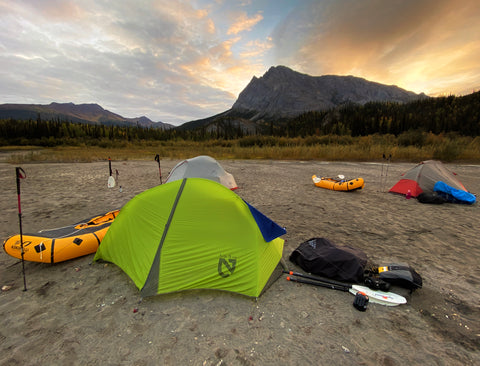PHOTOGRAPHY, BACKPACKING, & PACKRAFTING IN GATES OF THE ARCTIC NATIONAL PARK

Seeking a wilderness escape from the global pandemic, three friends embarked on a journey to one of the most wild and scenic areas on the continent, Gates of the Arctic National Park. Two of the members, Matt Meisenheimer and Max Foster, are professional landscape photographers and spent years studying the park for compelling mountains and rivers to photograph. This is their story.
Gates of the Arctic National Park is located in northern Alaska, beyond the Arctic Circle. It is the least visited national park yet the second largest in the US park system. Only 10,000 people visit the park each year and many of those visits are day trips via bush plan. For those who put the effort in, Gates of the Arctic features incredible mountain and arctic landscapes with abundant wildlife and wilderness solitude. Access is challenging though. There are no roads or trails in the park; it is pure wilderness. To visit and truly experience the place, backpacking or rafting is required.
After digitally scouting, studying maps, finding accessible areas and reading trip reports the group settled on late August to make their journey. Since the park is above the Arctic Circle, fall comes early. In late August, the tundra comes alive with vibrant reds, oranges and yellows as winter approaches. Since the group planned the trip during the 2020 pandemic, their entire schedule was canceled and rebooked several times, but after months of preparation, they successfully embarked on the Alaskan adventure.
The 11-day trip included four bush plane flights, 50+ miles of hiking, and 25 miles of pack rafting.
Map

Credit: National Park Service
When to Go
Gates of the Arctic National Park is fantastic year-round, although winter conditions are extremely harsh and dangerous for the ill prepared. In general, the best time to visit the park is summer or fall. Summer is filled with mosquitoes, but days are long and wildflowers are blooming. In fall, the tundra lights up with color and the mosquitoes are gone. Temperatures drop fast in fall and freezing temperatures are common during peak colors. Because the park is so far north, peak fall is usually the third or fourth week in August.

General Area & Plan
Our group backpacked the Arrigetch Peaks region of Gates of the Arctic. Arrigetch is the most popular backpacking area in the park, but it’s still remote and wild. It’s one of the most beautiful places I’ve been. The area is denoted
We planned 11 days so we would have plenty of time to explore the alpine peaks and valleys. We allotted additional time for photography since weather is very unpredictable. We also planned to packraft 25 miles on the nearby Alatna River on our last day.
Access is difficult and the biggest challenge is finding a suitable drop off and pick up point for your backpacking trip. We took bush planes from Bettles, Alaska, a very small town north of Fairbanks. We chose to be dropped off at Circle Lake, which allowed for an easier route to the Arrigetch Peaks. We elected to be picked up at Takahula Lake because of flight weight concerns if we returned to Circle. Circle Lake and Takahula are semi-connected via the Alatna River. Thus, on our final day we would packraft 25 miles south from the Circle Lake area to Takahula Lake.

Trip Information
We spent an incredible 11 days in the Arrigetch Peaks region and were treated to fantastic weather and light. We got extremely lucky, that’s for sure. We were also treated to comfortable temperatures. We were prepared for single digit temperatures, but never had to face them.
Since there are no trails, we spent our backpacking days creating our own paths. We did find a game trail or social path here and there, but bushwhacking was common. Our most difficult hiking occurred on the first and last day in the lower elevations of the tundra. We were forced to hike over what are called ‘tussocks’, which look like something out of a Dr. Seuss book. They are balls of tundra that are unstable and elevated over what is usually a wet area. They make for nightmarish hiking because you sink into them every step, oftentimes losing your balance completely and stepping into a nearby hole (that’s also usually filled with water). On our last day, we ran into a combination of tussocks and thick birch brush in an expansive wetland. We covered 1 mile in about 3 hours that day, to give you some idea of the slow going when terrain is tough.
The majority of our trip was spent in the alpine where hiking was much easier. We scrambled over scree fields and hiked on the hard tundra, where vegetation was minimal. The hiking was still difficult though with elevation gain, stream crossings, and very slippery boulder fields.

We returned to our drop-off point on day 10 and grabbed our cached rafting gear. Caching our rafts allowed us to save some weight during the heart of our trip. On day 11, we bushwhacked to the Alatna River, inflated our rafts, prepared our gear, and put in. The Alatna is sometimes called the ‘Flatna’ by packrafters. It is an easy paddle with no rapids. With the right wind, you can sometimes do 5-6 mph in a raft. We have a headwind so paddling was required, but it was definitely easy water.
We rafted 25 miles and then took out right next to Takahula Lake. We spent one night camped along the Alatna River on a sand bed, and it was a beautiful evening. We had a fire on the beach and enjoyed our last moments in the park.
One of the most difficult aspects of the trip was its duration. Being in the field 11 days means you obviously have to be self-sustainable and carry all necessary items with you. When you’re burning calories hiking, you need to eat a lot and having enough food is extremely important. So, carrying food for 11 days instantly puts the trip in strenuous territory. I averaged 2.5 lbs of food per day so my food alone was around 25 pounds. Now, add in camping, photography, and packrafting gear, and yeah, heavy packs.
My pack was most likely 60-70 pounds to start the trip. Each day though, the packs would get lighter and they felt much better on day 10 when we returned to our drop-off point.
For food, this was an average day –
Breakfast:
Oatmeal w/ peanut butter/coconut oil mix, coffee with coconut milk powder
Lunch:
Trail mix, energy bar, fruit leather, peanut butter, beef bar
Dinner:
Good To-Go dehydrated meal, dark chocolate bar
The park does have a healthy grizzly population so safe bear practices were necessary. The park also alerted us that there was a curious bear in the general area we were headed so we were diligent. We did run into that bear twice during our trip, but had no issues. Our entire group used Ursack bags to store our food properly. Ursack bags are great because they are effective and lightweight compared to a bear canister.

Packing List
- Nikon Z7
- Nikon 14-30mm f/4
- Breakthrough Filters X4 CPL
- 6 x batteries
- Zeiss Lens Cleaning Wipes
- 10 x lens clothes
Backpack
- Gregory Baltoro 85L Backpack
Sleeping Bag
- Marmot Helium 15 Down Sleeping Bag
Packrafting Gear
- Alpacka Caribou
- Aqua Bound Manta Ray 4-piece Paddle
- PFD
- Sea to Summit 35L Big River Dry Bag
Footwear
- LOWA Renegade GTX
- Brooks Cascadia Trail Runners
Shell/Rain Jacket & Pants
- Coalatree Barrage Tech Shell
- Marmot Precip Rain Pants
Down Jacket
- Rab Neutrino Endurance Down Jacket

Apparel
- 1 x Wool Long-sleeve Shirts
- 1 x Coalatree Evolution Hoodie
- 1 x Merino 250 Bottom Baselayer
- 2 x Coalatree Trailhead Pants
- 2 x Wool Socks
- 2 x ExOfficio Underwear
- Wool Hat
- Buff
- 2 x Gloves
- Quick-drying Camp Towel
Electronics
- Anker PowerCore 10000mAh Power Bank
- Black Diamond ReVolt Headlamp
- Phone Charger
- 3 x AAA Batteries
- Garmin inReach
- Anker Two Panel Solar Charger
- iPhone 11
Water
- 1 Liter Nalgene
- LifeStraw Go
Other Accessories
- Trekking Poles
- Ursack Bear Bag
- First Aid Kit
- Bear Spray
- Toiletries
- Hand Warmers
- Compass
- Paper Map
- MSR Pocket Rocket Stove
- GSI Soloist

Closing Thoughts
Overall, it was the trip of a lifetime. I went with one of my best photographer friends and this was the second trip we have gone on of this magnitude. Both were successful and a lot of fun. This trip was challenging, but rewarding. We were able to capture some great photos of a remote and beautiful area. I don’t think I’ve ever been somewhere as beautiful or raw. It was amazing wilderness and the fall colors were also spectacular. We definitely lucked out with the weather, but sometimes you get lucky and most of the time you don’t! Looking back, I’ve been fortunate to go on a lot of cool backpacks, but this one stands out as the best.














